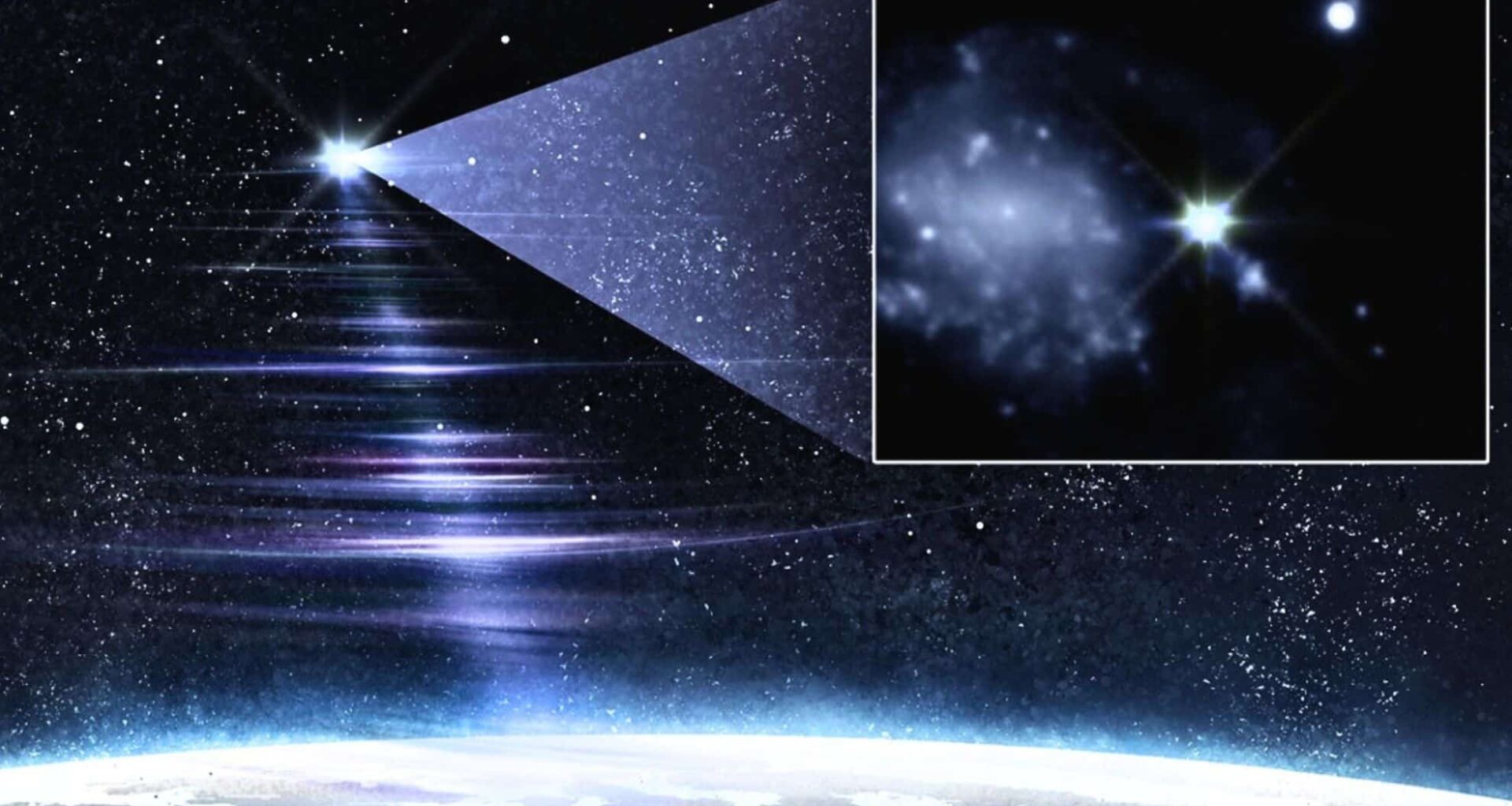A dazzling millisecond-long blast of radio waves, now confirmed as the brightest fast radio burst ever observed, has lit up a nearby galaxy in an event scientists are calling “RBFLOAT.” The signal, captured earlier this year, has triggered a wave of excitement among astronomers not just for its intensity, but for its proximity—placing it within what experts describe as our “cosmic neighborhood.”
In a peer-reviewed study published in The Astrophysical Journal Letters, researchers confirmed the burst came from a galaxy located just 130 million light-years away in the constellation Ursa Major—one of the closest recorded locations for this type of cosmic phenomenon. That proximity, paired with the burst’s exceptional brightness, has given scientists an unprecedented opportunity to study the source in detail.
Fast radio bursts (FRBs) are still among the most mysterious signals in modern astrophysics. First discovered in 2007, these ultra-brief emissions of radio waves often carry the energy output of several days’ worth of sunlight, condensed into just a few milliseconds. Over 4,000 have been detected to date, many by the Canadian Hydrogen Intensity Mapping Experiment (CHIME), but few have come with such clarity or traceability.
“This burst was so bright, we honestly thought something had gone wrong with the instruments,” said Amanda Cook, astrophysicist at McGill University and co-author of the study. “But when it passed every calibration test, we knew we were looking at something extraordinary.”
What Makes This Frb Different
The event, officially designated FRB 20240316A, has earned the informal nickname “RBFLOAT” — short for Radio Brightest Flash of All Time. The burst was detected on March 16 by CHIME and immediately flagged by its newly deployed Outrigger telescopes, an array of auxiliary detectors spread across British Columbia, California and West Virginia.
These outriggers are designed to dramatically improve the localisation of FRBs, which had previously been difficult to pinpoint due to the fleeting nature of the bursts. Acting together, the network was able to triangulate the source of RBFLOAT to the outer edge of a spiral galaxy thought to be NGC 4141.

“It’s like spotting a firefly from across the continent, and knowing which branch it’s sitting on,” said Shion Andrew, a graduate researcher at MIT’s Kavli Institute for Astrophysics and Space Research. “For FRBs, that level of precision is a game changer.”
Interestingly, while RBFLOAT is the brightest ever detected, its intrinsic energy output—that is, the actual energy it released at the source—is relatively average. According to the McGill team, it only appeared so luminous because of how close it is to us, losing less energy en route through space.
Clues Point to a Magnetar Hiding at the Galaxy’s Edge
Pinpointing the burst’s origin wasn’t just a technical feat — it opened a window into the physical environment of the source, offering rare insight into the kind of cosmic neighborhood that gives rise to such violent events.
The burst was traced to the outskirts of a young, star-forming region, a place teeming with stellar births and explosive ends. Follow-up observations from the James Webb Space Telescope revealed infrared emissions from the same location — a potential signature of a red giant star losing mass to a compact companion, or a magnetar surrounded by dusty debris.
Magnetars are highly magnetized neutron stars, born from supernovae, that are thought to be capable of emitting energy across the entire electromagnetic spectrum. Their powerful magnetic fields can twist and snap, launching massive flares in the form of X-rays, gamma rays — and in rare cases, radio waves.
“The infrared signature we saw might be reprocessed X-ray or gamma radiation,” said Peter Blanchard of Harvard University, according to Science News. “That gives us a rare multi-wavelength look at the burst’s environment, and possibly its cause.”
While magnetars have long been suspected as the culprits behind many FRBs, most of the evidence has been circumstantial. The combination of infrared and radio data in this case may bring researchers closer to confirmation.
A One-off Event With Implications for Cosmic Diversity
Despite extensive review of six years’ worth of CHIME data, no other bursts have been detected from RBFLOAT’s location, suggesting it may be a non-repeating FRB. That sets it apart from a handful of “repeaters” observed in the past, which periodically flash from the same source.
The difference between repeating and non-repeating FRBs remains one of the biggest open questions in astrophysics. Do they arise from different processes, or do they simply reflect different stages in the life of a magnetar or stellar system?
The location of RBFLOAT — just outside the centre of a star-forming region — may suggest its source is an older magnetar, one that’s had time to drift or evolve away from its birthplace. That detail could help researchers refine models of FRB progenitors, and how their signals might change over time.
“Every new FRB we can localize adds a piece to the puzzle,” said Kiyoshi Masui, associate professor at MIT and member of the CHIME collaboration. “And this one gave us more than just a piece — it gave us a whole corner of the puzzle.”

